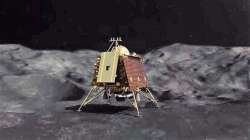'Expecting Vikram to function after free fall is similar to a dead person coming alive'
Dr. Thakkar said since it involves a large sum of public money, ISRO and those involved must ask difficult questions of themselves beyond just sentimentalism.

Raising several fundamental questions about the Vikram lander, an Indian American mechanical engineer has calculated that the it might have crashed at about 184 miles per hour (mph), a speed at which nothing of that value could have survived.
Dr. Bharat Thakkar, 77, is a veteran of quality control and reliability of systems, who has taught at several prestigious institutions in Chicago.
"These questions may be uncomfortable to those lay observers not trained in mechanics, projectile motion, horizontal and vertical velocities etc. They certainly go beyond any politics and ideology," Dr. Thakkar told News Agency IANS in an interview.
"Vikram was designed for soft landing. Is it true that there was no contingency in design for free fall any time during moon landing or any other time during Chandrayaan-2 mission? Expecting Vikram to function after free fall is a false hope similar to a ‘dead person' coming alive. Pulling the plug on ‘brain dead' is the right attitude. Expecting for divine intervention is very much cultural phenomenon in India," he said.
However, beyond that broad criticism, Dr. Thakkar made some very specific technical points. One relates to whether there was consideration in Vikram's design about "the moon's ‘coefficient of restitution' at the predetermined landing location".
"Upon free-falling from a 2.1 km height, Vikram would have bounced back and forth more than ten times in upright position (positive thinking) before coming to rest at a different location with a different coefficient of restitution than originally planned. During bouncing back and forth, the pre-determined centre of gravity of Vikram could have gone into anon-equilibrium position upon the first impact. Thus, is it not hopeless to think for Vikram to stay in upright position," he asked.
"A post-mortem must be carried out in terms of the mechanical design of Vikram. What was the factor of safety used in the dynamic mechanical design of Vikram? Was it even considered? These are the questions that need to be asked to ensure that upcoming missions do not suffer a similar fate," he said.
In arriving at the figure of a 184 mph crash, Dr. Thakkar, who calls himself as a great admirer of the Indian Space Research Organisation's (ISRO) passion, said: "Free fall velocity can be closer to square root of 2gh. Where g is one-sixth of earth (32.2 feet per sec2) h = 2.1 km = approximately 7,000 feet. With this free fall velocity of 270 ft per second = 184 miles per hour, nothing can survive at that speed."
"I am assuming ‘free-fall' but it is not exactly so. It is a minor thing but needs to be mentioned. At 2.1 km height, because of existing trajectory, there must be initial downward velocity. This is equivalent to forcing the tennis ball downward with a velocity that can rebound greater than free-fall. This downward velocity and coefficient of restitution combined can give us worst first bounce than I mentioned earlier.
He said that in his opinion, Vikram may have crushed on the first hit and there could have been no chance for subsequent bouncing.
"However, theoretically it is possible to have more bouncing like a tennis ball but Vikram is not a tennis ball," Dr. Thakkar reasoned.
"Anything four-legged falling does not necessarily hit all four legs at the same time depending upon the profile of moon's surface. It is always one leg touching first and taking all the forces due to free falling. If one leg is weakened, the rest cannot help the situation. The deformations that are plastic are not recoverable in metal and materials. Anyone making prediction with a common sense, Vikram was destroyed as soon as it hit the moon ground," he said.
Dr. Thakkar said since it involves a large sum of public money, ISRO and those involved must ask difficult questions of themselves beyond just sentimentalism.
"ISRO is a great enterprise and has done India proud. I am sure it has within its DNA the ability to ask brutally honest questions and come up with rational answers," he said.
Earlier today, ISRO Chief K Sivan said, "Regarding the lander, we have not been able to establish communication with it. Our next priority is Gaganyaan mission." Which means it's time we let go of the Vikram lander.
ISRO chief also confirmed that the rest of the Chandrayaan-2 mission is going on as planned.
India's resolve to emerge as a pioneer in space is no secret. Prime Minister Narendra Modi himself said after the communication was lost with the Vikram lander on September 7.
"There will be a new dawn, keep trying," Prime Minister Modi had said.
Heartfelt pictures of PM Modi consoling K Sivan after the hard landing were also seen.
(With IANS inputs)
ALSO READ | Stay well, Vikram
ALSO READ | Experts panel analysing cause of Vikram's failure
ALSO READ | Vikram Lander: Bitter goodbye or see you soon?